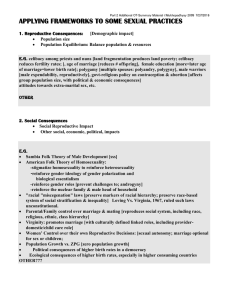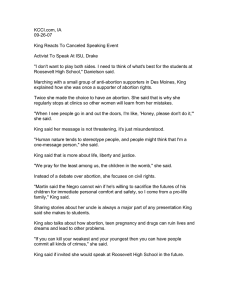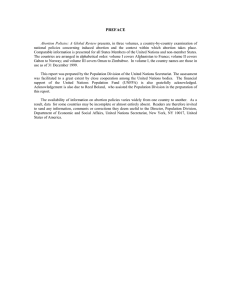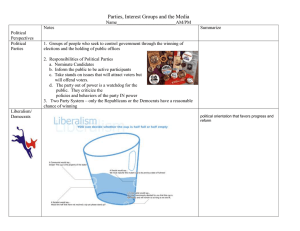ANNOTATED AND AMPLIFIED SUMMARY OF THEMES: ABORTION
advertisement
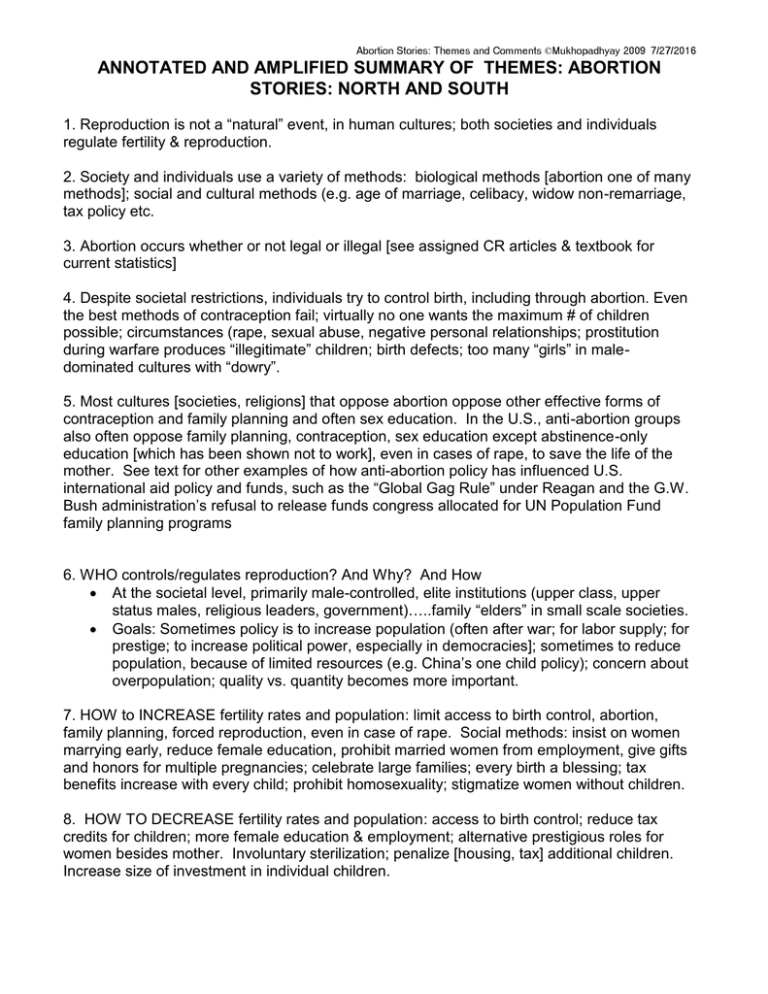
© ANNOTATED AND AMPLIFIED SUMMARY OF THEMES: ABORTION STORIES: NORTH AND SOUTH 1. Reproduction is not a “natural” event, in human cultures; both societies and individuals regulate fertility & reproduction. 2. Society and individuals use a variety of methods: biological methods [abortion one of many methods]; social and cultural methods (e.g. age of marriage, celibacy, widow non-remarriage, tax policy etc. 3. Abortion occurs whether or not legal or illegal [see assigned CR articles & textbook for current statistics] 4. Despite societal restrictions, individuals try to control birth, including through abortion. Even the best methods of contraception fail; virtually no one wants the maximum # of children possible; circumstances (rape, sexual abuse, negative personal relationships; prostitution during warfare produces “illegitimate” children; birth defects; too many “girls” in maledominated cultures with “dowry”. 5. Most cultures [societies, religions] that oppose abortion oppose other effective forms of contraception and family planning and often sex education. In the U.S., anti-abortion groups also often oppose family planning, contraception, sex education except abstinence-only education [which has been shown not to work], even in cases of rape, to save the life of the mother. See text for other examples of how anti-abortion policy has influenced U.S. international aid policy and funds, such as the “Global Gag Rule” under Reagan and the G.W. Bush administration’s refusal to release funds congress allocated for UN Population Fund family planning programs 6. WHO controls/regulates reproduction? And Why? And How At the societal level, primarily male-controlled, elite institutions (upper class, upper status males, religious leaders, government)…..family “elders” in small scale societies. Goals: Sometimes policy is to increase population (often after war; for labor supply; for prestige; to increase political power, especially in democracies]; sometimes to reduce population, because of limited resources (e.g. China’s one child policy); concern about overpopulation; quality vs. quantity becomes more important. 7. HOW to INCREASE fertility rates and population: limit access to birth control, abortion, family planning, forced reproduction, even in case of rape. Social methods: insist on women marrying early, reduce female education, prohibit married women from employment, give gifts and honors for multiple pregnancies; celebrate large families; every birth a blessing; tax benefits increase with every child; prohibit homosexuality; stigmatize women without children. 8. HOW TO DECREASE fertility rates and population: access to birth control; reduce tax credits for children; more female education & employment; alternative prestigious roles for women besides mother. Involuntary sterilization; penalize [housing, tax] additional children. Increase size of investment in individual children. © 9. The burden of multiple pregnancies falls primarily on women, especially if unmarried; but married men also suffer from too many children to support; may abandon children, commit suicide or take dangerous, high-paying jobs. 10. Poorer people are more negatively impacted by lack of access to abortion and family planning than wealthier people e.g. children sold into sex trade, child labor, marry girls off early; infanticide [twins, girls]; child neglect or abandonment 11. Cultures have different theories about reproduction; but they also ADJUST their theories to justify changing conditions and motivations e.g. Catholic Church—shifts in its views as to when the soul enters the conceptus. Note also current attempts in the U.S. to legislate human personhood beginning at the point of conception—with 14th amendment rights—as part of a larger anti-abortion, anti-contraception campaign [e.g. Human Life Amendment of the Republican Party, Colorado in 2008 and 2010]. 12. Look at reproductive and social reproductive consequences of policies and beliefs [and which groups benefit most, politically, economically, socially] as a way of understanding the origins of and support for these policies, practices and beliefs. 11. The Current “Pro-Choice” vs. “Pro-Life” political rhetoric in the U.S. is much too simplistic. It also both hides and raises serious issues of “church” vs. “state” separation; of cultural & religious diversity vs. one culture/religion dominating public policy. Pro-“Life”: really anti-abortion. Should it be called “forced reproduction”. When does “life” begin; a sperm is life; a cell is life; life is a continuum; when is it a “child”? At 6 weeks with gills and a tail; at 3 months with no functioning brain?; “viability”; What about concern for the “life” of born children? The mother? The family? The social impact? What about all the unwanted children, here and in the world? And why not oppose warfare and other violence that kills innocents? What about overpopulation? Quantity vs. Quality. And why oppose family planning/contraception. Pro-Choice: multiple levels o Choice of abortion [and other legal reproductive methods] by those who have no opposition to the procedures. Relatively straightforward especially given the diverse positions on the issue and the wide-spread support internationally. o Reproductive decisions should be totally a woman’s personal choice. This is more problematic. Should it be a purely personal choice, regardless of societal consequences. Is this realistic? Socially responsible? What role should the social or economic or ethical impacts play? E.g. What if some or even many women decided they wanted 10-15 or even 6 children? What about the impact on society, the societal “costs” if society is committed to public education and health care for all children? Is this feasible? Realistic? Fair? Who should pay? What about the environmental impacts? Issues of crowding, etc. These are complex issues including what methods could be used to discourage or encourage women/families to make socially responsible fertility decisions. 12. Other themes you found in the film or can think of?
